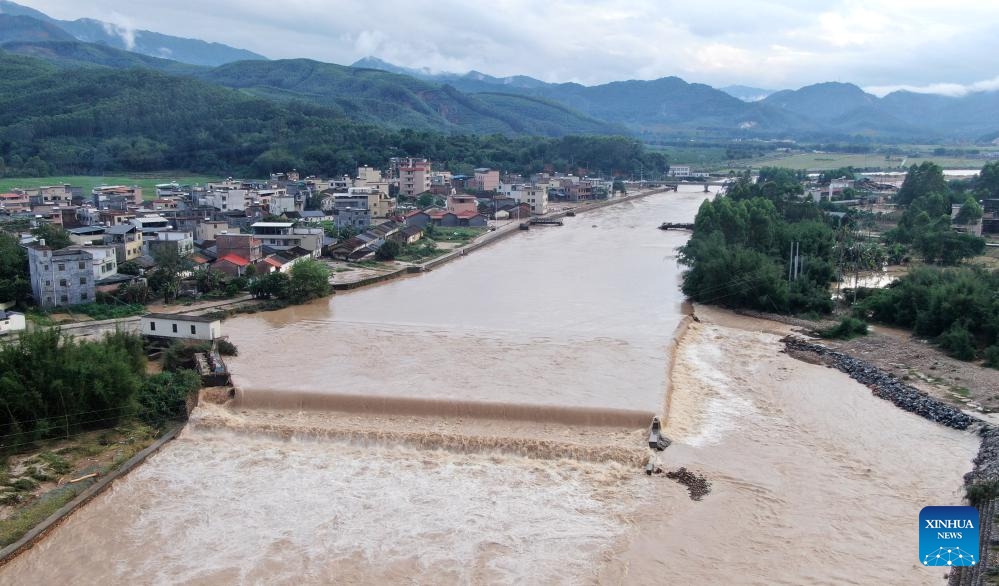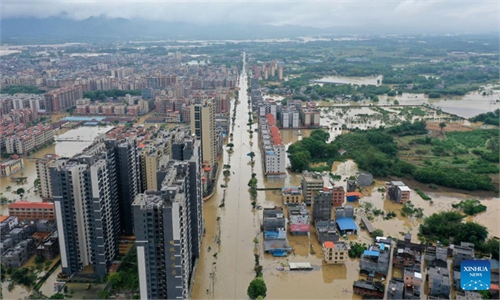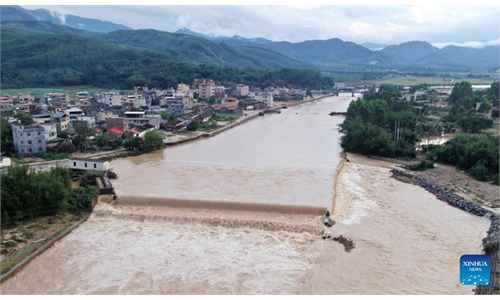Rainfall intensifies in southern China; cities strengthen monitoring to prevent disasters

An aerial drone photo taken on April 21, 2024 shows a view of the Beijiang River tributary in Wujiang District of Shaoguan City, south China's Guangdong Province. A total of 38 hydrological stations at 24 rivers in south China's Guangdong Province have reported water levels surpassing the alert threshold as of 4 p.m. on Sunday, according to the provincial department of water resources.(Photo: Xinhua)
It is expected that starting Wednesday night, rainfall in the southern region of China will intensify again, with heavy rain covering most parts of Guangdong, and some areas may encounter over 250 millimeters of rainfall, the National Meteorological Center (NMC) announced on Tuesday. The NMC forecast that on Tuesday and Wednesday, some areas in the southern coastal regions of Guangdong and northeastern part of Guangxi Zhuang Autonomous Region may still experience heavy to torrential rain, urging the public to continue monitoring disaster prevention measures.
The NMC said that from April 19 to 22, more than 10 national meteorological observation stations in South China's Guangdong Province recorded daily rainfall exceeding historical April extremes.
The NMC forecast that on Tuesday and Wednesday, the range of heavy rainfall in areas including the regions south of the Yangtze River will be slightly reduced compared to the previous period, but some areas in the southern coastal regions of Guangdong and northeastern part of Guangxi Zhuang Autonomous Region may still experience heavy to torrential rain, urging the public to continue monitoring disaster prevention measures, avoid entering geological disaster-prone areas, and be vigilant against secondary disasters such as flash floods, landslides, and mudslides that continuous rainfall may trigger.
In recent days, strong convective weather and continuous heavy rainfall have been observed in the central and northern regions of Guangdong. This round of heavy rainfall is mainly concentrated in the Beijiang River Basin, covering a wide upstream catchment area. The rapid rise of river water levels in Shaoguan area has made it one of the localities most severely affected by the current period of rainfall.
Meanwhile, the Shenzhen Meteorological Bureau issued an orange alert for heavy rain on Tuesday. To prevent disasters, students can delay going to and leaving school, and those on their way to or from school should seek shelter in nearby safe places. Large outdoor activities should be suspended, and individuals and units should stop high-altitude and outdoor operations. Safety precautions should be taken for outdoor electricity facilities in low-lying areas, and outdoor electrical safety should be ensured.
In addition, vehicles are advised to try to avoid waterlogged sections and sunken overpasses and avoid parking in low-lying and flood-prone areas. In case of serious flooding or other dangerous situations, vehicles should be abandoned for immediate evacuation.
Relevant emergency response departments and rescue units are asked to strengthen their duty, closely monitor the disaster situation, implement traffic diversion and drainage measures in flooded areas, and relocate people from dangerous areas to safe places for temporary shelter.
The NMC on Monday issued a yellow alert for rainstorms and a blue alert for severe convection weather as heavy downpours as well as thunderstorms, gales and hail are anticipated to lash parts of the country, including parts of Guangdong Province and Guangxi Zhuang Autonomous Region, from Monday to Tuesday.
Central government departments dispatched a total of 15,000 relief supplies, including 6,000 folding beds, 6,000 towels, and other essentials, to rain-battered Guangdong Province on Monday.
The disaster in Guangdong has resulted in the deaths of four people, including one rescue worker from Shaoguan. Additionally, 10 people are still missing, according to the Xinhua News Agency on Monday. About 110,000 people have been relocated in Guangdong, according to the Xinhua report.
According to Xinhua News Agency, the Chinese Ministry of Emergency Management (MEM) announced on Monday that, key areas will ensure sufficient emergency relief supplies, swiftly organize emergency rescue operations, and fully guarantee the life-saving passage for emergency rescue in Jiangwan town, Shaoguan city. During the intermittent period, preparations will be made for the prevention and response of the next round of heavy rainfall.
The relevant person in charge of the MEM stated that the working group of the National Headquarters for Flood Control and Drought Relief will strengthen supervision and guidance in key areas.
These key areas will deploy high-tech equipment for levee inspection and risk assessment, strengthen inspections and defenses of major dikes such as the Beijiang River embankment. Authorities will carefully prepare safety evacuation plans for areas prone to flash floods and geological disasters, as well as high-risk areas, promptly and decisively evacuate threatened individuals, and intensify inspections of dangerous buildings, old houses, and temporary structures in flooded areas to prevent secondary disasters.
The official stated that the current round of rainfall in southern China is gradually easing, while noting that significant rainfall in some areas with high intensity, compounded by the impact of heavy rain and flooding remained a concern. Risks such as river flooding, flash floods, geological disasters, and urban waterlogging remain prominent, and the flood control and disaster relief situation remains severe.
Global Times


